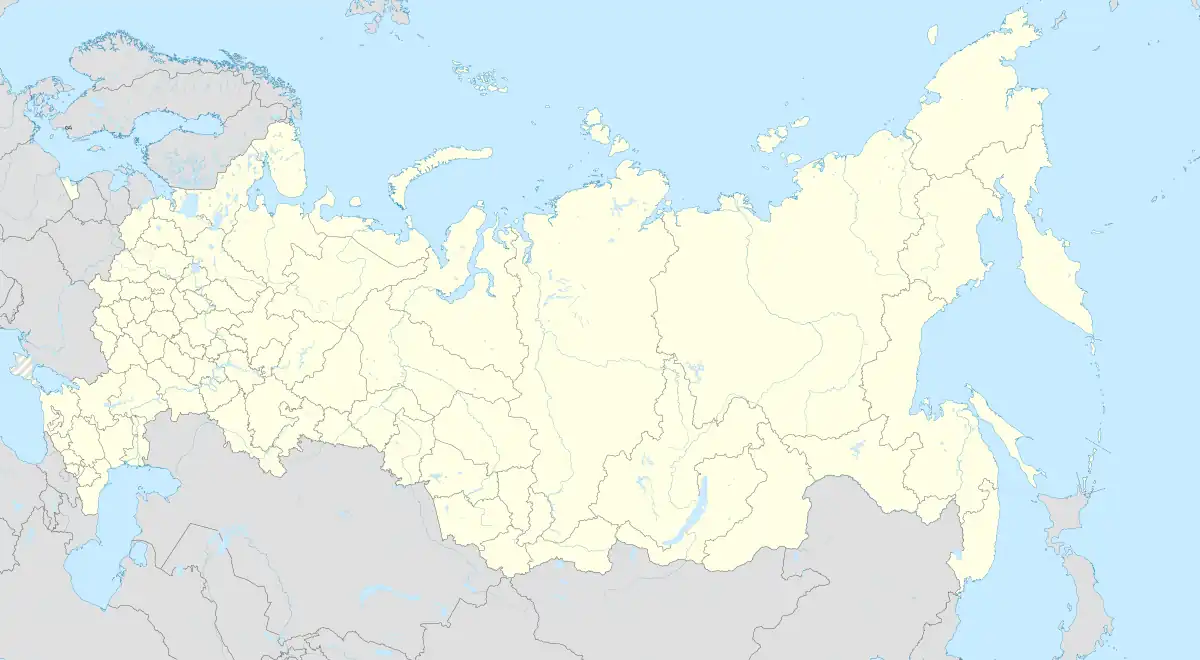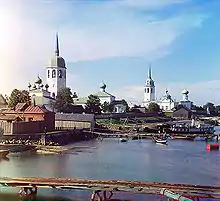Novaya Ladoga
Novaya Ladoga (Но́вая Ла́дога) is a town in Volkhovsky District of Leningrad Oblast, Russia, located at the point where the Volkhov River flows into Lake Ladoga, 140 kilometers (87 mi) east of St. Petersburg. Population: 8,838 (2010 Census);[3] 9,920 (2002 Census);[8] 11,310 (1989 Census).[9]
Novaya Ladoga
Новая Ладога | |
|---|---|
.png.webp) Flag  Coat of arms | |
Location of Novaya Ladoga | |
 Novaya Ladoga Location of Novaya Ladoga  Novaya Ladoga Novaya Ladoga (Leningrad Oblast) | |
| Coordinates: 60°06′N 32°18′E | |
| Country | Russia |
| Federal subject | Leningrad Oblast[1] |
| Administrative district | Volkhovsky District[1] |
| Settlement municipal formation | Novoladozhskoye Settlement Municipal Formation[1] |
| Founded | 15th century[2] |
| Town status since | 1704[2] |
| Elevation | 144 m (472 ft) |
| Population | |
| • Total | 8,838 |
| • Estimate (2018)[4] | 8,203 (−7.2%) |
| • Capital of | Novoladozhskoye Settlement Municipal Formation[1] |
| • Municipal district | Volkhovsky Municipal District[5] |
| • Urban settlement | Novoladozhskoye Urban Settlement[5] |
| • Capital of | Novoladozhskoye Urban Settlement[5] |
| Time zone | UTC+3 (MSK |
| Postal code(s)[7] | 187450, 187453 |
| OKTMO ID | 41609104001 |
History

The Nikolo-Medvedsky (St. Nicholas) Monastery stood on the site of the modern town since the 15th century,[2] but the nearby sloboda was long overshadowed by the first Russian capital, Staraya Ladoga, located just a few miles upstream. In 1702–1704, during the Great Northern War, Peter the Great established a shipyard there, fortified the monastery, and ordered the population of Staraya Ladoga to relocate to the nearby village. Town rights were granted to it in 1704.[2] The newly founded town grew in importance in connection with construction of the Ladoga Canal and Volga–Baltic Waterway in the 18th and 19th centuries.
In 1719, Novaya Ladoga was included to St. Petersburg Governorate.[10] In 1727, separate Novgorod Governorate was split off, and in 1773 Novoladozhsky Uyezd, with its seat in Novaya Ladoga, was established.[10] In 1776, the area was transferred to Novgorod Viceroyalty and in 1781, it was moved back into St. Petersburg Governorate.[10] On December 9, 1922, the administrative center of the uyezd was moved to the selo of Gostinopolye, which was renamed Volkhov and was granted town status.[11] The uyezd was renamed Volkhovsky.[11] In 1924, the changes were rolled back, the administrative center moved to Novaya Ladoga, and Volkhov was demoted to a selo (which was eventually renamed Gostinopolye).[11] The name of the uyezd, however, remained Volkhovsky.[11]
On August 1, 1927, the uyezds were abolished and Volkhovsky District, with the administrative center in the urban-type settlement of Zvanka, was established.[12] The governorates were also abolished and the district became a part of Leningrad Okrug of Leningrad Oblast.[12] On July 23, 1930, the okrugs were abolished as well and the districts were directly subordinated to the oblast.[12]
On March 20, 1946, Novoladozhsky District with the administrative center located in Novaya Ladoga was split off Volkhovsky District.[12] On February 1, 1963, Novoladozhsky District was abolished and merged into Volkhovsky District.[12]
Administrative and municipal status
Within the framework of administrative divisions, it is, together with four rural localities, incorporated within Volkhovsky District as Novoladozhskoye Settlement Municipal Formation.[1] As a municipal division, Novoladozhskoye Settlement Municipal Formation is incorporated within Volkhovsky Municipal District as Novoladozhskoye Urban Settlement.[5]
Economy
Industry
Industrial facilities in Novaya Ladoga include shipyards and food industry enterprises.
Transportation

The M18 Highway, connecting St. Petersburg and Murmansk, passes close to Novaya Ladoga. In Kiselnya, close to Novaya Ladoga, a highway heading to Vologda via Tikhvin and Cherepovets branches off. The town is also connected by a road to Volkhov, with a regular bus traffic.
The Volkhov River is navigable within the district; however, there is no passenger navigation. In the beginning of the 19th century, a system of canals bypassing Lake Ladoga were built, which at the time were a part of Mariinsky Water System, connecting the Neva River and the Volga River. In particular, the Syas Canal connects the Syas and the Volkhov. The New Ladoga Canal connects the Volkhov and the Neva. It replaced the Old Ladoga Canal, built by Peter the Great, which thus became disused and decayed. The canals collectively are known as the Ladoga Canal.
Culture and recreation

The district contains seven cultural heritage monuments of federal significance and additionally five objects classified as cultural and historical heritage of local significance.[13] The federal monuments are the trading arcades, the Nikolo-Medvedsky Monastery, the monument erected to commemorate the opening of the Ladoga Canal, as well as two buildings related to the activities of Alexander Suvorov, who was a regiment commander in Novaya Ladoga, and the building hosted the headquarters of the Ladoga Military Flotilla during World War II.
References
Notes
- Oblast Law #32-oz
- Энциклопедия Города России. Moscow: Большая Российская Энциклопедия. 2003. p. 303. ISBN 5-7107-7399-9.
- Russian Federal State Statistics Service (2011). Всероссийская перепись населения 2010 года. Том 1 [2010 All-Russian Population Census, vol. 1]. Всероссийская перепись населения 2010 года [2010 All-Russia Population Census] (in Russian). Federal State Statistics Service.
- "26. Численность постоянного населения Российской Федерации по муниципальным образованиям на 1 января 2018 года". Federal State Statistics Service. Retrieved January 23, 2019.
- Law #56-oz
- "Об исчислении времени". Официальный интернет-портал правовой информации (in Russian). June 3, 2011. Retrieved January 19, 2019.
- Почта России. Информационно-вычислительный центр ОАСУ РПО. (Russian Post). Поиск объектов почтовой связи (Postal Objects Search) (in Russian)
- Russian Federal State Statistics Service (May 21, 2004). Численность населения России, субъектов Российской Федерации в составе федеральных округов, районов, городских поселений, сельских населённых пунктов – районных центров и сельских населённых пунктов с населением 3 тысячи и более человек [Population of Russia, Its Federal Districts, Federal Subjects, Districts, Urban Localities, Rural Localities—Administrative Centers, and Rural Localities with Population of Over 3,000] (XLS). Всероссийская перепись населения 2002 года [All-Russia Population Census of 2002] (in Russian).
- Всесоюзная перепись населения 1989 г. Численность наличного населения союзных и автономных республик, автономных областей и округов, краёв, областей, районов, городских поселений и сёл-райцентров [All Union Population Census of 1989: Present Population of Union and Autonomous Republics, Autonomous Oblasts and Okrugs, Krais, Oblasts, Districts, Urban Settlements, and Villages Serving as District Administrative Centers]. Всесоюзная перепись населения 1989 года [All-Union Population Census of 1989] (in Russian). Институт демографии Национального исследовательского университета: Высшая школа экономики [Institute of Demography at the National Research University: Higher School of Economics]. 1989 – via Demoscope Weekly.
- Новая Ладога, г. (in Russian). Энциклопедия "Культура Ленинградской области". Retrieved March 18, 2014.
- Новоладожский уезд (1917 г. – февраль 1923 г.), Волховский уезд (февраль 1923 г. – август 1927 г.) (in Russian). Система классификаторов исполнительных органов государственной власти Санкт-Петербурга. Archived from the original on February 22, 2014. Retrieved March 18, 2014.
- Волховский район (август 1927 г.) (in Russian). Система классификаторов исполнительных органов государственной власти Санкт-Петербурга. Archived from the original on March 17, 2014. Retrieved March 18, 2014.
- Памятники истории и культуры народов Российской Федерации (in Russian). Russian Ministry of Culture. Retrieved June 2, 2016.
Sources
- Законодательное собрание Ленинградской области. Областной закон №32-оз от 15 июня 2010 г. «Об административно-территориальном устройстве Ленинградской области и порядке его изменения», в ред. Областного закона №23-оз от 8 мая 2014 г. «Об объединении муниципальных образований "Приморское городское поселение" Выборгского района Ленинградской области и "Глебычевское сельское поселение" Выборгского района Ленинградской области и о внесении изменений в отдельные Областные законы». Вступил в силу со дня официального опубликования. Опубликован: "Вести", №112, 23 июня 2010 г. (Legislative Assembly of Leningrad Oblast. Oblast Law #32-oz of June 15, 2010 On the Administrative-Territorial Structure of Leningrad Oblast and on the Procedures for Its Change, as amended by the Oblast Law #23-oz of May 8, 2014 On Merging the Municipal Formations of "Primorskoye Urban Settlement" in Vyborgsky District of Leningrad Oblast and "Glebychevskoye Rural Settlement" in Vyborgsky District of Leningrad Oblast and on Amending Various Oblast Laws. Effective as of the day of the official publication.).
- Законодательное собрание Ленинградской области. Областной закон №56-оз от 6 сентября 2004 г. «Об установлении границ и наделении соответствующим статусом муниципального образования Волховский муниципальный район и муниципальных образований в его составе», в ред. Областного закона №17-оз от 6 мая 2010 г «О внесении изменений в некоторые областные законы в связи с принятием федерального закона "О внесении изменений в отдельные законодательные акты Российской Федерации в связи с совершенствованием организации местного самоуправления"». Вступил в силу через 10 дней со дня официального опубликования (24 сентября 2004 г.). Опубликован: "Вестник Правительства Ленинградской области", №27, 14 сентября 2004 г. (Legislative Assembly of Leningrad Oblast. Oblast Law #56-oz of September 6, 2004 On Establishing the Borders of and Granting an Appropriate Status to the Municipal Formation of Volkhovsky Municipal District and to the Municipal Formations Comprised By It, as amended by the Oblast Law #17-oz of May 6, 2010 On Amending Various Oblast Laws Due to the Adoption of the Federal Law "On Amending Various Legislative Acts of the Russian Federation Due to the Improvement of the Organization of the Local Self-Government". Effective as of after 10 days from the day of the official publication (September 24 2004).).